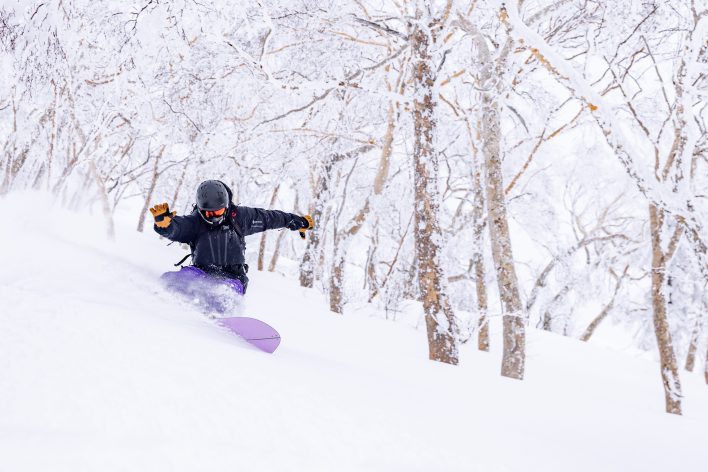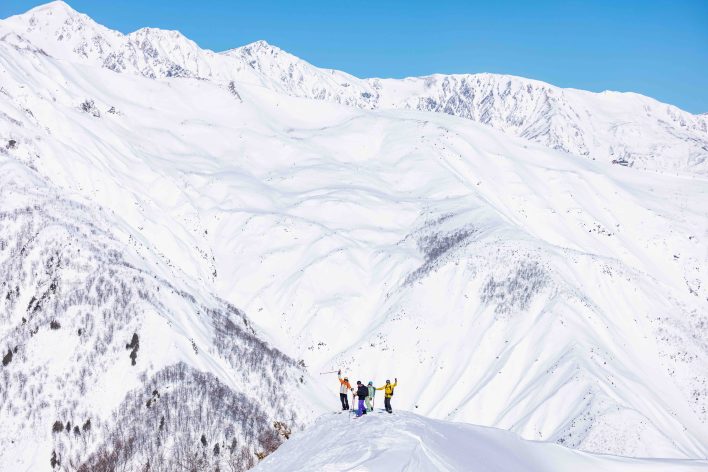
When I started planning a trip to Japan, my boss, Adam Howard, offered one suggestion: “Go to the Japanese Alps.” Before his recommendation, my plans revolved around powder chasing on Hokkaido, Japan’s north island, and my knowledge of the mountains on Japan’s main island was limited to the 1998 Nagano Olympics. I started researching the 60 mile-long mountain range. I learned about Hakuba Myoko and Nozowaonsen.
The Japanese Alps may not be on the bucket list of many skiers and snowboarders, but they are still a popular destination for foreigners. They’re popular among Japanese urbanites looking to escape the city and Australians. While I understand why folks defer to Hokkaido—the snowfall is more consistent and ski media glorified the destination—the terrain can’t stack up to what Hakuba and the surrounding areas have to offer. Booking a trip to Alps, with less snowfall than Northern Island was a gamble. PowderQuest was the professional I chose to help me make the best of my limited time.
The Japanese Alps consist of three ranges – the northern Hida and central Kiso, as well as the southern Akaishi. It’s a young range, which came to be just 2.5 million years ago when oceanic plates collided under Japan, thrusting the 60 miles of peaks up to almost 10,000 feet. Later, volcanoes and glaciers covered the land. With the unique mix of Cascade-like craters and Alaska-like spines, it’s no wonder that the Freeride World Tour uses Hakuba’s Happo Ono resort for one of the four-star qualifier events and a junior tour stop.
Mo Rasiah is the owner and lead guide of Crystalline Backcountry and PowderQuest. He says he loves to do three things: eat, walk uphill and powder ski. I spent a week with him and can attest to the fact that he is able to do all three things quite quickly. Rasiah is in heaven with the Japanese Alps.

“Hokkaido may have the advantage over the Japanese Alps in terms of consistency. But when the stars align and when it’s on in the Northern Alps, it’s hard to beat that combination of world class terrain combined with the Japanese snow machine,” explains Rasiah. “Magic happens, and if you’ve experienced this, you’ll know exactly what I mean. If not, you gotta just come find out.” Over seven days of touring, he showed us the magic.
In the first half of our trip, I was blown away by the sheer size of the terrain. The next day we were looking over the edge of a crater and preparing to jump in. Nori Suzuki was our tail guide and she worked with Rasiah throughout the day to find the softest, deepest, and least tracked terrain.
We were told by the locals that we had been lucky. The week prior to the snow, it had been rain. We hit the perfect atmosphere flow. We had light snow throughout the day. This allowed us to catch glimpses of sunlight on the rimmed trees. At night, the storms picked up, dumping fresh snow to fill in yesterday’s tracks. After four days of this, we picked up our pace and moved on to Hakuba.
We arrived in Hakuba to find the snow melting, but the cold air coming from the Sea of Japan was keeping it soft. We explored canyons on the sides of two local resorts. Hakuba’s peaks are spine-like but less volcanic in nature than Myoko. We danced through tree fingers and alpine basins. Yuki Hirata pointed out to us the lines that Jeremy Jones, Travis Rice, and other film crews rode in Hakuba. He shared with us his impressive snowboard mountaineering line after some prompting.

There were crowds on the boot packs and skintracks out of the resorts, but the terrain is so massive that we didn’t see a single other group until our lines converged with the standard outtrack just below a dam.
After the ski day, we explored the towns. Iiyama, outside of Myoko had very little English signage. While I walked the 10 minutes from the station to the hotel, all road signs were in Japanese. The snow was melted by a system that pumped water from hot springs underground to the surface. The hotel was geared towards Japanese businesspeople and not tourists from abroad. Green tea was served instead of coffee and tatami mattresses were used instead of beds. Breakfast consisted of fish and rice with pickled vegetables.
Hakuba has a more touristy atmosphere than Iiyama. Australian and American visitors roam the streets, frequenting English-language-friendly bars. We drank espressos and ate a breakfast of cereal, fruit and eggs, while looking out over the ski jumps that were used in the Nagano Games 1998. Many of the buildings around town were built in the ’90s in anticipation of the Olympics. Iiyama and Myoko had an old-fashioned feel, with buildings that looked like they’d been there for hundreds of years. Hakuba is unique, and has a modern, more contemporary look. The exteriors of the buildings are influenced by Swiss chalets. The interiors are straight out of a ’90s sitcom: geometric designs, unexpected pops of color and sliding glass doors.
On our last day skiing in Hakuba, our luck ran out. On our outtrack, we had to skate through the rain and battled high winds. On any ski trip, six days of powder skiing is a success. And rain or snow, we were waiting in town for shabu-shabu. This Japanese hot pot was ready.
Like Rasiah said, conditions don’t always line up in the Japanese Alps, but our gamble paid off. With the help of our guides, we skied in deep snow and ate delicious foods while avoiding crowds. Hokkaido had been shut down by a severe wind event. While scrolling through my friends’ social media posts stuck on the north island I was reminded of how every ski trip is an unpredictable gamble. Places that advertise 300 days of sunshine still get rain and the powder capital of the world doesn’t guarantee untracked laps. The Japanese Alps offer a unique combination of volcanic and ice-formed terrain.
Backcountry Magazine published the first article Pachinko Slots – Gambling in Japan’s Alps.

